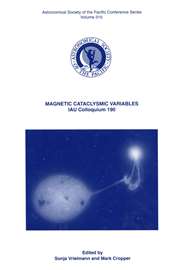Article contents
Orbital Evolution of the Lunar Ejecta
Published online by Cambridge University Press: 27 February 2018
Abstract
We have estimated the flux of lunar ejecta near the Earth, e.g., the cumulative flux of ejecta larger than 10-13g is 10-10particles cm-2s-1. In addition, our numerical simulations for the orbital evolution of lunar ejecta lead to the orbital characterization of these ejecta. Since our calculations suggest that the incident direction of lunar ejecta onto the Earth is nearly isotropic, it is expected that the dynamical properties of lunar ejecta make it possible to distinguish them from other IDPs.
- Type
- I. Dynamics of the Interplanetary Dust Cloud
- Information
- Copyright
- Copyright © Astronomical Society of the Pacific 1996
References
- 1
- Cited by


